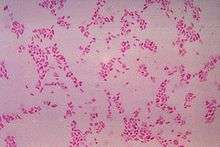Bacteroides fragilis
| Bacteroides fragilis | |
|---|---|
 | |
| Scientific classification | |
| Kingdom: | Bacteria |
| Phylum: | Bacteroidetes |
| Class: | Bacteroidetes |
| Order: | Bacteroidales |
| Family: | Bacteroidaceae |
| Genus: | Bacteroides |
| Species: | Bacteroides fragilis |
Bacteroides fragilis is an obligately anaerobic, Gram-negative, rod-shaped bacterium. It is part of the normal flora of the human colon and is generally commensal,[1][2] but can cause infection if displaced into the bloodstream or surrounding tissue following surgery, disease, or trauma.[3]
Epidemiology and pathogenesis
The B. fragilis group is the most commonly isolated Bacteroidaceae in anaerobic infections, especially those that originate from the gastrointestinal flora. B. fragilis is the most prevalent organism in the B. fragilis group, accounting for 41% to 78% of the isolates of the group. These organisms are resistant to penicillin by virtue of production of beta-lactamase, and by other unknown factors.[4]
This group was formerly classified as subspecies of B. fragilis (i.e. B. f. ssp. fragilis, B. f. ssp. distasonis, B. f. ssp. ovatus, B. f. ssp. thetaiotaomicron, and B. f. ssp. vulgatus). They have been reclassified into distinct species on the basis of DNA homology studies.[5] B. fragilis (formerly known as B. f. ssp. fragilis) is often recovered from blood, pleural fluid, peritoneal fluid, wounds, and brain abscesses.
Although the B. fragilis group is the most common species found in clinical specimens, it is the least common Bacteroides present in fecal flora, comprising only 0.5% of the bacteria present in stool. Their pathogenicity partly results from their ability to produce capsular polysaccharide, which is protective against phagocytosis[6] and stimulates abscess formation.[3]
B. fragilis is involved in 90% of anaerobic peritoneal infections.[7] It also causes bacteremia[8] associated with intraabdominal infections, peritonitis and abscesses following rupture of viscus, and subcutaneous abscesses or burns near the anus.[9] Though it is gram negative, it has an altered LPS and does not cause endotoxic shock.
| Bacteroides fragilis | |
|---|---|
| Classification and external resources | |
| MeSH | D001442 |
Treatment
In general, B. fragilis is susceptible to metronidazole, carbapenems, tigecycline, beta-lactam/beta-lactamase inhibitor combinations (e.g., Unasyn, Zosyn), and certain antimicrobials of the cephalosporin class, including cefoxitin. The bacteria have inherent high-level resistance to penicillin. Production of beta lactamase appears to be the main mechanism of antibiotic resistance in B. fragilis.[10] Clindamycin is no longer recommended as the first-line agent for B. fragilis due to emerging high-level resistance (>30% in some reports).[11][12]
Environmental research
B. fragilis bacteriophages are commonly used as tracers of human faecal material.[13]
See also
References
- ↑ Kuwahara T, Yamashita A, Hirakawa H, et al. (October 2004). "Genomic analysis of Bacteroides fragilis reveals extensive DNA inversions regulating cell surface adaptation". Proc. Natl. Acad. Sci. U.S.A. 101 (41): 14919–24. doi:10.1073/pnas.0404172101. PMC 522005
 . PMID 15466707.
. PMID 15466707. - ↑ http://prod.hopkins-abxguide.org/pathogens/bacteria/anaerobic_gram-neg._bacilli/bacteroides_fragilis.html?contentInstanceId=255919
- 1 2 Levinson, W. (2010). Review of Medical Microbiology and Immunology (11th ed.).
- ↑ Snydman DR, Jacobus NV, McDermott LA, et al. (January 2010). "Lessons learned from the anaerobe survey: historical perspective and review of the most recent data (2005–2007)". Clin. Infect. Dis. 50 (Suppl 1): S26–33. doi:10.1086/647940. PMID 20067390.
- ↑ Baron EJ, Allen SD (June 1993). "Should clinical laboratories adopt new taxonomic changes? If so, when?". Clin. Infect. Dis. 16 (Suppl 4): S449–50. doi:10.1093/clinids/16.Supplement_4.S449. PMID 8324167.
- ↑ Wexler HM (October 2007). "Bacteroides: the good, the bad, and the nitty-gritty". Clin. Microbiol. Rev. 20 (4): 593–621. doi:10.1128/CMR.00008-07. PMC 2176045
 . PMID 17934076.
. PMID 17934076. - ↑ Bacteroides infections at eMedicine
- ↑ Brook I (June 2010). "The role of anaerobic bacteria in bacteremia". Anaerobe. 16 (3): 183–9. doi:10.1016/j.anaerobe.2009.12.001. PMID 20025984.
- ↑ Brook I (October 2008). "Microbiology and management of abdominal infections". Dig. Dis. Sci. 53 (10): 2585–91. doi:10.1007/s10620-007-0194-6. PMID 18288616.
- ↑ Ayala, J.; Quesada, A.; Vadillo, S.; Criado, J. N.; Píriz, S. (2005). "Penicillin-binding proteins of Bacteroides fragilis and their role in the resistance to imipenem of clinical isolates". Journal of Medical Microbiology. 54 (11): 1055. doi:10.1099/jmm.0.45930-0.
- ↑ Mandell GL, Bennett JE, Dolin R (2004). Principles and Practice of Infectious Diseases (6th ed.). Churchill Livingstone. ISBN 0-443-06643-4.
- ↑ Brook I (December 2007). "Treatment of anaerobic infection". Expert Rev Anti Infect Ther. 5 (6): 991–1006. doi:10.1586/14787210.5.6.991. PMID 18039083.
- ↑ "Environment and Public Health Research Unit (EPHRU)". University of Brighton. Archived from the original on 15 May 2009.
External links
- Bacteroides references in Baron's Medical Microbiology (online at the NCBI bookshelf).
- Type strain of Bacteroides fragilis at BacDive - the Bacterial Diversity Metadatabase